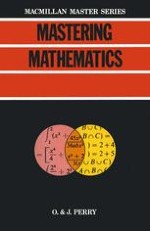1982 | OriginalPaper | Chapter
Algebraic Equations and Inequalities
Authors : O. Perry, J. Perry
Published in: Mastering Mathematics
Publisher: Macmillan Education UK
Included in: Professional Book Archive
Activate our intelligent search to find suitable subject content or patents.
Select sections of text to find matching patents with Artificial Intelligence. powered by
Select sections of text to find additional relevant content using AI-assisted search. powered by
Placing an equals sign between two algebraic expressions implies that they have the same numerical value <math display='block'> <mrow> <mn>2</mn><mi>x</mi><mo>=</mo><mn>10</mn><mo>,</mo><mtext> </mtext><mtext> </mtext><mn>3</mn><mi>x</mi><mo>−</mo><mn>2</mn><mo>=</mo><mi>x</mi><mo>+</mo><mn>4</mn><mo>,</mo><mtext> </mtext><mtext> </mtext><msup> <mi>x</mi> <mn>2</mn> </msup> <mo>−</mo><mn>5</mn><mi>x</mi><mo>−</mo><mn>6</mn><mo>=</mo><mn>0</mn> </mrow> </math>$$2x=10,\quad \quad 3x-2=x+4,\quad \quad {{x}^{2}}-5x-6=0$$ are all equations in one unknown, x, which is called the variable. In order to maintain the equality, whatever change is made to the expression on one side of an equation must also be made on the other side.
